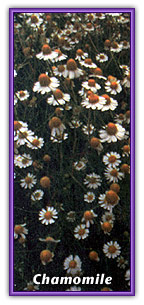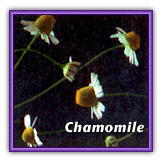 Source
Source
Chamomile (or German camomile) is the dried flower head of an annual member of the aster family. The primary chamomile of commerce, it is grown in Hungarv, the Czech Republic, Slovakia, Germany, Argentina, and Egypt. Roman (or English) chamomile, the flower of the perennial Chamaemelum nobile (formerly Anthemis nobilis), is less frequently seen in the American market.
Traditional Use
According to Varro Tyler, Germans call chamomile alles zutraut-"capable of anything". A Slovakian chamomile specialist, Ivan Salamon, states: Chamomile is the most favored and most used medicinal plant in Slovakia. Our folk saying indicates that an individual should always bow when facing a chamomile plant. This respect results from hundreds of years' experience with curing in folk medicine of the country. Chamomile has been used for centuries to quiet an upset stomach promote urination and relieve colic, and as a mild sleep aid. Topically, it has been used to reduce inflammation and soothe aches, and to heal cuts, sores, and bruises.
Current Status
Today's uses of chamomile differ little from those of ancient times. Chamomile is an official drug (recognized by government authority) in the pharmacopoeias of twenty-six countries. Anti-inflammatory, antiseptic, carminative, antispasmodic, and mild sedative activity as well as promotion of wound healing have been attributed to alpha-bisabolol, which comprises 13 percent of the essential oil. Another constituent, chamazulene, which comprises 5 percent of the essential oil, has been credited with relieving spasms, inflammation, pain, and allergy (but see "Cautions" on the next page). In Europe, chamomile is used externally in compresses, rinses, or gargles; to treat inflammations and irritations of the skin and mucous membranes, including the mouth, gums, and respiratory tract; and for hemorrhoids. Chamomile tea or tincture relieves spasms and inflammation of the gastrointestinal tract as well as peptic ulcers. A mild tea makes a gentle sleep aid, particularly for children. Modern indications are backed not only by intensive recent research (except for sleep aid claims), but also by many centuries of common use.
 Preparations
Preparations
Dried flowers, herbal teas, capsules, salves, creams, tinctures, bath products, and other preparations are available in the American market.
Cautions
Persons who are allergic to the pollen of other members of the aster family, such as ragweed, may also be allergic to chamomile. Teas made from the dried flowers also contain pollen. Chamomile is associated with rare contact dermatitis. At least one case of anaphylactic shock has been attributed to drinking chamomile tea. Varro Tyler points out, however, that of fifty allergic reactions to "chamomiles" reported in the literature, only five were attributed to German chamomile, thus attesting to the herb's relative safety. Worldwide, approximately a million cups of chamomile tea are consumed daily.
Symptoms
Indigestion
Insomnia
Nausea
Actions
Anti-inflammatory
Promotes wound healing

![]()
![]()
![]()
 Source
Source Preparations
Preparations